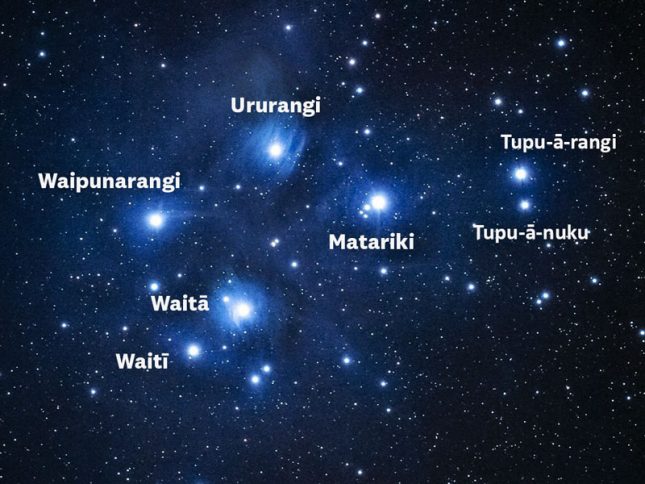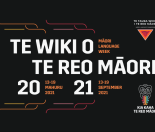Matariki the Māori New Year, is rich with tradition. Discover the importance of Matariki, and explore ways that you can celebrate the Māori New Year with your family. This year Matariki will be officially celebrated on 28 June 2024.
What is Matariki the Māori New Year?
Matariki is the Māori name for a group of 7 stars known as the Pleiades star cluster. Note, some hapū know the Matariki as 9 stars (although the last 2 can be hard to make out with the naked eye).
Some people think of Matariki as a mother star with 6 daughters, and it is often referred to as the Seven Sisters.
Others think that Matariki are the ‘eyes of the god’. When Ranginui, the sky father, and Papatūānuku, the earth mother, were separated by their children the god of wind, Tāwhirimātea, became angry, tearing out his eyes and hurling them into the heavens.
Matariki appears in the eastern sky sometime around the shortest day of the year, and is thought to determine how successful the harvest crop will be in the coming season. The brighter the stars, the more productive the crop will be.
What does Matariki mean?
Matariki has two meanings, both of which refer to the cluster of stars. Mata Riki means Tiny Eyes, and Mata Ariki means Eyes of God.
To learn more about the story of the Eyes of God, check out this awesome animation by Atawhai Tibble. This video was made for Year 1 students, although it’s still quite haunting. The original story from the people of Ngai Tuhoe has Tawhirimatea ripping his eyes out and throwing them to the heavens. In this version he uses his tears:
Courtesy: Atawhai Tibble
History of Matariki
Matariki’s story threads deep into the fabric of Māori tradition. For centuries, the rising of this star cluster wasn’t just about marking a new year; it carried immense significance for our ancestors.
See, Matariki’s appearance was a vital signpost for those connected to the land. The brightness of its stars was believed to foretell the coming season. Clear, dazzling stars? That meant a bountiful harvest – a cause for celebration. Hazier skies indicated leaner times ahead, a signal to prepare carefully.
But Matariki’s significance goes beyond the practical. It was also a time steeped in remembrance, a period to honour those who had passed since the last rising of the stars. Their spirits were thought to ascend with Matariki into the night sky, transforming into stars themselves.
What are the Matariki star names?
Although there are actually 1000’s of stars that make up the pleaides cluster, and there are technically 9 stars that make up the constellation, there’s just 7 stars you can really make out with the naked eye.
It’s these 7 stars that have traditionally been known as the 7 sisters, or the Matariki. The Matariki star names are:
Alcyone – Matariki, eyes of Tāwhirimātea
Atlas – Tupu-ā-rangi, sky tohunga
Electra – Waipuna-ā-rangi, sky spring
Taygeta – Waitī, sweet water
Pleione – Tupu-ā-nuku, Earth tohunga
Merope – Ururangi, entry to the heavens
Maia – Waitā, sprinkle of water
As Dr Matamua notes some Iwi make out 9 stars in the constellation, but it is very difficult to make these out with the naked eye. The two extra stars are:
Pōhutukawa – connects Matariki to the dead and is the star that carries our dead across the year (Sterope/Asterope).
Hiwaiterangi/Hiwa – is the youngest star in the cluster, the star you send your wishes to (Celaeno).
When is Matariki celebrated?
In 2024, Matariki is officially celebrated on 28 June.
Matariki begins to rise in the last few days of May and into June, and is different every year, and this symbolises the coming of the Māori New Year.
Some iwi, or tribes, started celebrations when Matariki was first seen, others would celebrate on the first new moon after Matariki, and still others on the first full moon.
The Matariki new moon happens some time in June or July each year.
Some people celebrate the New Year on the day the new moon rises, and others celebrate on the day after the new moon. Celebrations can last for up to 3 days. The modern option for the Maori New Year is to pick a day between the new and full moons, and this has become the more traditional date.
Previous Matariki dates:
In 2022, Matariki will begin on 21 June, with the public holiday recognised on 24 June 2022.
Is Matariki a public holiday?
Yes, Matariki is a public holiday in New Zealand. New Zealand’s then Prime Minister Jacinda Ardern revealed the date for New Zealand’s first ever Matariki public holiday. That holiday was held on 24 June 2022. And it was a huge success around the country!
The date for the Matariki public holiday will change each year, as the dates for Matariki rising change. But the holiday, itself, will always be celebrated on either a Monday or a Friday.
This allows the traditional long weekend, and will be a great cause to celebrate what may now become Aotearoa-New Zealand’s New Year!
How to find the Matariki star cluster
Educator Martin Langdon, on behalf of Te Papa Museum shows us how to find the Matariki star cluster in this awesome short video:
Courtesy: Museum of New Zealand Te Papa Tongarewa
Why was Matariki important?
Matariki harvest
The disappearance of Matariki in Autumn, signals the time to gather and preserve crops. The Matariki disappear from view in April, and reappear again in late May/early June. So this was an important marker in the harvest calendar.
After the harvesting of traditional crops, such as kumara, pikopiko and karaka berries, when the storehouses were full, Māori would celebrate the harvest season. This celebration coincided with the reappearance of Matariki.
Matariki crop planting
In years gone by, Matariki was thought to determine your crop for the coming season, so it was important to recognise the part it played in nature’s cycle.
Matariki atua ka eke mai i te rangi e roa,
E whāngainga iho ki te mata o te tau e roa e.
Divine Matariki come forth from the far-off heaven,
Bestow the first fruits of the year upon us.
Māori used Matariki as a signal for when to plant their crops after the long winter. If the stars were clear and bright, it was a sign that a favourable and productive season lay ahead, and planting would begin in September.
If the stars appeared hazy and closely bunched together, a cold winter was in store and planting was put off until October.
Nowadays, Matariki is still seen as an important time to celebrate the earth, and show respect for the land on which we live.

How was Matariki celebrated?
Traditionally Matariki was celebrated by gathering with whanau (family) and reflecting on the past.
The festival’s connection to the stars provided an opportunity for families to remember their whakapapa (genealogy) and those ancestors who had passed away to the heavens. Offerings were made to land-based gods who would help provide good crops, and new trees were planted to signal new beginnings.
Many of these traditional celebrations are still practiced today, however there are many others ways that Matariki is celebrated also. Most celebrations focus around music, song, dance, food and family, and celebrations can last up to 3 days.
How do communities recognise Matariki?
Matariki is a good opportunity for Māori to share their stories and culture with the wider community, and many events and activities are planned throughout the country to share and celebrate Matariki. Some common events and activities include:
- Concerts and cultural performances
- Art exhibitions
- Art and Craft Workshops
- The sharing of myths and legends
- Astronomy Workshops
- Hangi and Feasts
- Dawn Ceremonies
- Family Days
- Tree Planting in Conservation Areas
- Whakapapa (Genealogy) Workshops
- Cooking Demonstrations
You might also be interested in this collection of New Zealand television content focused around Matariki.
Or you can check out our Matariki events and activities around New Zealand page.
Celebrating Matariki Across Aotearoa
While the spirit of Matariki unites us as Kiwis, the ways we celebrate this special time have a beautiful local flavour across our islands. Here’s a glimpse into some of the ways different communities mark the Māori New Year:
-
Food for the Soul: Sharing a hearty hākari (feast) is a staple of Matariki. Traditional foods often feature, like seafood gathered in winter, produce from preserved stores, and even special dishes representing specific stars of the Matariki cluster. Think warm boil-up, comforting hangi, or even sweet treats infused with native ingredients.
-
Whānau Connection: Matariki is a time to come together. Whether that’s a simple shared meal at home or a big community gathering, the focus is on reconnecting with loved ones. Storytelling, games, and simply enjoying each other’s company are central to the festivities.
-
Cultural Events: Many towns and cities host special Matariki events. These might include kapa haka performances, stargazing workshops, art exhibitions inspired by the stars, or even dawn ceremonies at significant sites. These events offer a great chance to experience the richness of Māori culture.
Regional Flavours
- Northland: Often incorporates seafaring traditions due to the coastal communities.
- Auckland: Boasts a diverse Matariki calendar, from museum events to vibrant street festivals.
- Wellington: Known for Matariki-themed light displays and city-wide celebrations.
Important Note: It’s always best to research events happening in your specific area throughout the Matariki period. Local libraries, and council websites often have great listings.
6 simple ways to celebrate Matariki with your family
There are lots of ways you can celebrate Matariki with your family, and in doing so, start your own family traditions. Some ideas to get you started include:
1. A Family Feast
Make Matariki a time when the whole family gets together to feast and give thanks. It may be a nice opportunity to explore traditional Māori food like hangi and rewena, or Māori bread. Our star-shaped sugar cookies will go down well for desert.
2. A New Harvest
Use Matariki as a time to clear the winter vegetables, and prepare your vegetable garden for the new planting. It could become a family tradition to do the gardening altogether – at least for one day of the year.
3. Learn a new Karakia
A new booklet containing Matariki karakia (prayers) is now available. There is one karakia for each of the 9 stars of Matariki.
4. Sleep Under the Stars
Spend a night sleeping under the stars (or under a tent!), and tell your own family stories. You may want to talk about family memories, or create goals for the coming lunar year.
5. New Years Resolutions
Most of us create New Years resolutions in January, but by the time June rolls around they are long forgotten. Why not use Matariki as a time to renew your resolutions.
6. Attend a Matariki Event
For more great ideas on how to spend Matariki with your friends and family, check out our Fresh ideas for celebrating Matariki with your Family.
Happy New Year Aotearoa-New Zealand!
Check out this article for a great range of Matariki craft ideas to do with your kids. Or try out our 9 simple Matariki inspired craft ideas. Get baking with our star-shaped sugar cookie recipe. Or find out some Fresh ideas for celebrating Matariki this year with your family!







Matariki is the eyes of chiefs… Mata Ariki..is the eyes of Ta’aroa. Matariki is located in Hauviri marae and Mata Ariki is located in the Taputapuatea marae in the Opoa district of Ra’iatea ( Havai’i / Hawaiki ). If one stands at the coronation stone in Hauviri and looks straight ahead and follow the direction , you will land at Whitianga, the home of ” Te Wahine Moeroa Taputapuatea ” roughly translated to “the sleepy /sleeping woman of Taputapuatea “. It sits next to the Taputapuatea stream. Theres a place north of whitianga called Tahanga which contains a navigational site… Read more »
this has been very help ful
Awesome, glad you found it useful. — Kiwi Families
hi
MATIRIKI SUCKS I THINK ITS STUPID
What a really odd comment to make? Anyway, we LOVE Matariki and have been promoting it as a significant and important event in the Aotearoa-New Zealand calendar for over 10 years. Each to their own though! — Jarrod
matariki is great the maori new year
Good to see that Matariki is celebrated
We agree! — Kiwi Families
Hello. And Bye.
this website sucks
Pretty rude comment. We work really hard week in-week out to make this site a success. And we’re still going strong after almost 15 years. But thanks for stopping by. — Jarrod
Hello. And Bye.
Hello. And Bye.
Hi excellent website! Does running a blog like this take a massive amount work? I have absolutely no expertise in computer programming however I was hoping to start my own blog soon. Anyhow, if you have any ideas or tips for new blog owners please share. I understand this is off subject but I simply needed to ask. Kudos!
It sure does, but it’s a LOT of fun. We recommend anyone start a blog! — Kiwi Families
When in Cambodia, we celebrated International, Khmer and Chinese New Years. Here, we celebrate Matariki and International New Year. Makes more sense too* celebrate a winter New Year than a summer one. I can only think of one reason why people would have a problem with that.
*Thats to make Paulette Stewart happy. BTW, Paulette, Maori should be capitalised, you pedantic dumbass.
Lot of assumptions there. When was the first written account? Did Capt Cook mention it?
Of course there are a lot of assumptions there! You’re referring to cultures that passed on knowledge through oral rendition. There is no first written account. The Maori compass includes Matariki on it, so we can assume Matariki was used for navigational purposes, and that would infer Matariki was ‘recorded’ prior to 1500AD ( https://teara.govt.nz/en/diagram/2222/maori-star-compass). Captain Cook’s historical, and more importantly cultural, accounts of the Maori people leave a lot to be desired! — Jarrod
Wonder what your issue with Capt Cook?
I find Matariki unusual in that there are absolutely no references to it prior to say the year 2000. All down to oral tradition you say.
Just wanted to know how many countries celebrate Matariki
Hi Ataahua, another great question! The easy answer is just one: Aotearoa! Matariki is a uniquely Maori custom, so it’s only celebrated here. The more difficult answer would be to say which cultures around the world use the Pleiades constellation for agricultural purposes. I’m sure there are many, throughout Polynesia, Melanesia, Asia, South America and beyond. Good luck in your search. — Jarrod
When was it first recorded? Google no help
Hi Jon, this is a great question, and not one with a straightforward answer! Maori have used the Matariki, and other constellations, for agriculture, religious and navigational uses since earliest memory. So at least as far back is 1500AD. Maori arrived in Aotearoa from East Polynesia, and possibly from South East Asia prior to that. We know they’ve used the stars for navigational purposes for thousands of years. So it’s safe to assume that Matariki was identified many thousands of years ago. In terms of Matariki used as part of the planting/harvesting cycle, we can assume this knowledge was brought… Read more »
it is common historical knowledge that Tē Hekenganui The great Māori migration happened between 1250 to 1350AD not 1500 as you have stated. Ngā mihi
Thanks for this. I’ve re-read the article and I can’t find a reference to that date. Very happy to update though if it’s incorrect! — Kiwi Families
See also my reply to your post above, Jon Lee
https://www.facebook.com/Livingbythestars/videos/2050060725248229/
Do you think the government should acknowledge Matariki with a public holiday?
Hi Amber, here at Kiwi Families we are huge supporters of a nationally recognised Matariki! Whether or not a public holiday is called for, I’m not sure. But we should certainly celebrate the Maori New Year with the same sort of fervour that China celebrates their New Years. On that note, we’re stoked that Wellington City Council made a huge call to cancel Guy Fawkes , and replace it with a mid-winter Matariki fireworks display. It’s a step in the right direction! — Jarrod
“The reappearance of the seven Matariki stars, in late May or early June, signals the beginning of the Māori New Year”. I got this small piece from the Museum of New Zealand Te Papa Tongorewa. Actually, the reappearance of the NINE Matariki stars signalling the Maori New Year will appear in July. We celebrate Matariki from the 17th of July to around the 27th of July. During this period there are some days where we do not celebrate.
There are two stars missing. Hiwaiterangi and Waiti. Hiwaiterangi is the wishing star. There is a special process for this. Waiti is the star used to establish whether it will be a good year for things like eel etc. The stars are also positioned wrong. On your diagram Tupuanuku is above Tupuarangi. Nuku is always below Rangi. Papatuanuku (Earth Mother), Ranginui (Sky Father)……hence nuku below and rangi above.
hi
When was this website made please…..as i am doing a powerpoin presentation on matariki thank you.
Hi Jordan, we kicked off 10 years ago in 2006. Good luck with your presso — Jarrod
Hi i was wondering
why is Matariki important to Māori
Please answer asap
I need it for tommorw
thankyou so much for your web sight its amazing
its helped me heaps
thx
Hi Ne’ve, Matariki is important to Maori for a number of reasons. The seven sisters signified a time for harvesting crops, as well as for celebrating and being with whanau/family. Matariki is also important spiritually for many Maori and the stars were used for navigation purposes. — Jarrod.
what do u mean???
what did Maori ancestors use Matariki for in the past
I just want to find out What do the seven stars signify?
I just want to know “How was Matariki first discovered?”
This doesn’t help me, I want to find out about “how many clusters of stars make up matariki”
Hi there, Matariki refers to the Pleiades constellation, which is a cluster made up of nine bright stars: https://en.wikipedia.org/wiki/Pleiades — Jarrod
matariki is one star cluster made up of seven bright stars
Minecraft
So retaded
Did you know that the Japanese car name Subaru means matariki,which is why there are seven stars on their emblem,?
Yes! That’s right – great point 🙂 Thanks for reminding me!
there’s actually nine stars. There are two more named (pohutukawa & hiwa-i-te-rangi)
Awesome, thank you. We’ve since updated the article 🙂 — Jarrod
hey can you put in some facts? that would be cool
Hi Archie, what kinds of facts were you after?
cool facts
I still don’t get what matariki day is can you please help me figure out for my homework at school.=)
hi just wanted to ask how did the maori ancestors use matariki and for what?
LOLZ!!!
I AM NEW MY SCHOOL IS POINT VEIW!!!!!!!!!!!!!!!!!
Don’t say I am not allowed please this is the best web site I could find…..
Hi I am from Point veiw neon1234 is not my name and I am here to know stuff about matariki for my homework
Matariki has been celebrated by Maori as part of our heritage since way back however the marketing and exploitation of this integral part of our annual calendar has seen modern day NZers view it as merely a festival. In western terms I would liken it to xmas celebrations but without presents, a time for families to gather together but for Maori it also means to remember those who have passed on and celebrate those who have joined the family fold, re-establishing and maintaining our whakapapa links. It also signifies the times to prepare for planting/harvesting and by the appearance of… Read more »
Do you celebrate Matariki in other countries? What do you eat in Matariki?And possibly do you know what year it started? Sorry for all the question.
What do people give to each other on matariki?
Thank you for the very much for your detailed ‘treatise’ – article of Matariki and the Maori New Year. I digress a little and will return: My wife and I watched a documentary a few days ago where some of the Greatest Historians of our time ‘greatly lauded’ Polynesians (as a whole) as the most skilled sea travelers in history. They said Polynesians saw the Pacific Ocean as a ‘great highway’ and used it to it’s full capacity, and not only did they ‘give tribute’ to our Waka-taua (twin canoe catamaran) but also to the great skill of ‘Navigation by… Read more »
really nice information about matariki
Iam a Māori as well and I love it !!!!!!!!!!!!!!!!!:)
very good site,answered all of the questions i had!!!!
I can’t help but think that you ask questions for answers you already know! If you are looking for answers research your questions instead of using a site like this to request answers. A lot of people have there own beliefs about matariki and will elaborate accordingly. Which will provide you with a different context to your own answers. It has been written basically for you above this comment box area.
chip man here
hi tirarau
Umm…if you read the article at the top it will tell you what matariki is, its significance and why we celebrate during this time of the year. It may not be recognised world wide, but if you had a ethnic population in the billions then Id say you stand a better chance of becoming more recognised. I dont know why im even answering some of the dumb n ignorant posts on here. Do some research before posting dont be lazy and or ignorant.
How long do the celebrations go for?
When is the maori new year?
Matariki comes at the last days of may and is between June and July
so so so so so so so so so so so so so so so so so cooooolllll : )